Companies with a real passion for their product can be hard to come by these days. However, recently, we connected with Maine Guide Snowshoes, and they are the real deal. Maine Guide Snowshoes not only has a passion for what they do, but they make a tried and true product, all while giving back to the community.
Owned by Robert F. (Bob) & Andrea Howe, Maine Guide Snowshoes (MGS) is a company that takes pride in the craftsmanship of their ’shoes, all handmade in Maine. While other companies may be focused on aluminum or plastic frames, MGS is made of traditional white ash, and with good reason- they are the best. “After trying every conceivable frame over the last 25 years, I still believe white ash is the best”, says Bob Howe.
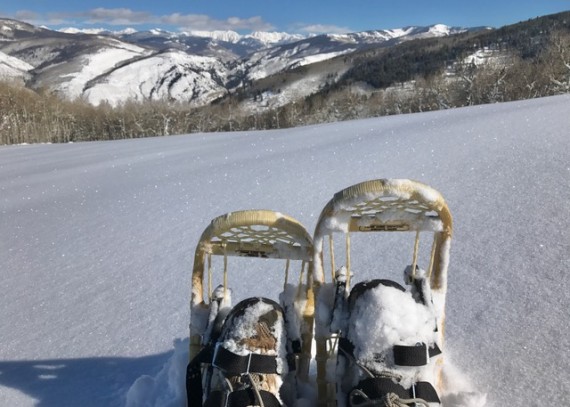
Using Maine Guide Snowshoes from the Eastern Hillside at Beaver Creek, CO, which is a backcountry trail in winter. Photo courtesy of Judy Holmes.
About Maine Guide Snowshoes
Three things ring true of this family-owned Maine company and truly set it apart from others in the field: high-quality white ash, their dedication and service to the community, and their true love and commitment for the outdoors.
THE WHITE ASH CHOICE
Why white ash, you might ask, when there are less expensive aluminum models out there with bright colors and chic styles? In the frigid weather typical in Northern Maine, aluminum snowshoes tend to fail. If you are out in temperatures twenty degrees below zero F, your snowshoe can break within minutes and leave you stranded. Yes, aluminum snowshoes may be lightweight. However, they are not large enough to have holes for the snow to fall back through as you step. So, the user ends up shipping snow onboard their decking and bogging down.
Several years ago, Bob had a client come to hunt rabbits; he stopped and bought a pair of aluminum snowshoes on his way. He could have gone with a traditional pair of wooden shoes from Bob, but he thought he knew best. Five minutes out on the trail, and they broke before the price sticker was even off the product.
PINE GROVE PROGRAMS – FROM THE HEART
Though, the unique aspect of this Maine company is that its proceeds from snowshoe sales go to support the Pine Grove Program, which offers free outdoor adventures for active military service members, veterans, and other heroes, including Gold Star families and first responders. In 1998 the Howes bought Pine Grove Lodge & Cabins in Pleasant Ridge, ME, now a licensed 501c. 100% of the proceeds support their events for veterans.
Bob did not serve in the military himself, coming of age at the end of the Vietnam War. However, he felt a need to help in some way. His Dad and other mentors had served, so at age 20, Bob began taking local veterans out on snowshoes to hunt, fish, and do other activities. As Andrea mentioned, “Bob felt that this was what he could offer, and he would go to the local VFW and other places where military veterans hung out and ask “Hey, anybody want to go fishing?”.
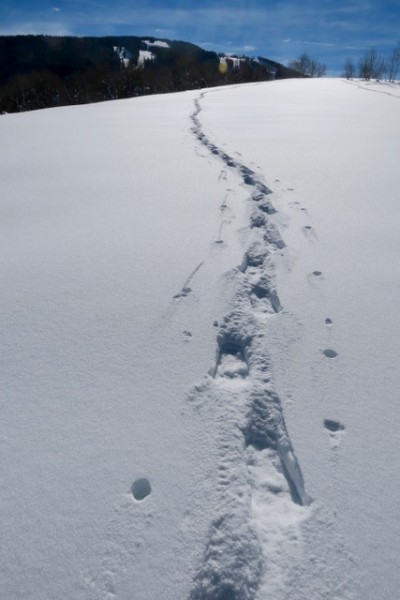
Snowshoeing can be a great escape to witness the beauty of Mother Nature. Photo courtesy of Judy Holmes.
A current project through the Pine Grove Programs is a fundraiser for the Joseph Murphy Memorial Cabin. The cabin will be free to veterans and first responders to use “as a quiet respite from the stress they are enduring,” says Bob. Joe Murphy, whom the cabin is named after, tragically took his own life after military deployment. He loved fishing and hunting in Maine outdoors.
For readers interested in knowing more about the heroic mission and purpose of Pine Grove Programs, visit www.pinegroveprograms.org. You can donate directly on their website if you find meaning in all that MGS and Pine Grove do to make the lives of our active military and veterans better.
MAINE GUIDE SNOWSHOES GOING STRONG
Alongside the work they do in the community, Bob and Andrea’s love for their product and the true outdoors is evident. In a recent interview with Andrea, she said Bob was 18 years old when he got his license as a Maine Guide, a prestigious achievement. I’m a former Mainer myself, and I know this achievement is a big deal for outdoorsmen and women.
In Northern Maine, where the Howes family lives, snowshoes are a necessity for most people who are out and about in the outdoors. Hunters, loggers, snowmobilers, and adventurers need them. “If your snowmobile breaks down and you are five miles back in the words with bad weather conditions, you may not make it out alive without a pair,” warns Bob. “Mother Nature hasn’t changed much over the years. She is as brutal now as she ever was and can still kill you in the blink of an eye.”
When the Howes bought the lodge, most of their snowshoe business was local. Today, over twenty years later, Maine Guide Snowshoes is known for making its high-quality snowshoes for people who depend on them, like hunters, wardens, foresters, and sappers. Bob’s years of hunting and guiding in the woods back his product.
Read More: The Future of Traditional Snowshoes: We Value Our 6,000 Year Tradition
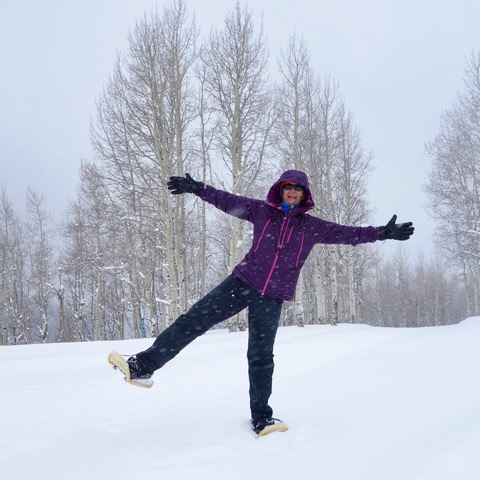
Maine Guide Snowshoes can be used for fun, recreational snowshoeing too. Photo courtesy of Judy Holmes
The Maine Guide Product
We know the importance of white ash for colder climates, like Northern Maine. However, there are a few other aspects to consider when choosing your traditional snowshoe. Maine Guide Snowshoes offers an insider’s perspective.
FOUR STYLES AND HOW TO CHOOSE
Before heading out on a pair of traditional ‘shoes, you need to consider your body weight. Also, keep in mind the kind of snow you will be traveling on your outing. Hard packed snow can support more weight than the light, fluffy stuff. For people who need to be out there in all conditions, owning more than one pair of snowshoes is an excellent idea.
As any snowshoer knows, there are many styles for different conditions. However, the years of experience behind MGS have winnowed the product down to four basics, with a brand new addition to their line.
- The ALASKAN shoe is for deep snow and maximum weight, 175-300 pounds (79-136 kg), with a significant upturn, so the wearer does not sink. It has a long tail for proper tracking and best for flat terrain.
- The SPORTSMAN offers foot support with a maximum weight of 150-250 lbs. This model comes with a short tail that won’t get caught in trees and brush, your all-around condition choice.
- MODIFIED BEARPAW is one of their original designs and a go-to for many snowshoers with a shorter, wider framer than the Sportsman or Alaskan.
- The BEAVERTAIL, similar to the modified Bearpaw, is a rounded style with an upturn on the back of the snowshoe, providing for a low drag factor and maneuverability.
- MGS’s newest offering is the RABBIT HUNTER, the first model with reverse! This one is great for backing up (not an easy task in most snowshoes). The Rabbit Hunter is also designed to lie flat on top of the snow, with little drag and increased floatation.
Read More: Traditional Wooden Snowshoes: Shapes, Designs, Names
THE TIES THAT BIND
After deciding to buy a pair of traditional wooden snowshoes, the next consideration is the ties, and then the harness, or binding. MGS offers three options for snowshoe ties.
Traditional RAWHIDE is a favorite among many veteran outdoorsmen and women. However, these ties require regular care with varnish to prevent damage from moisture and wear and tear. Not to mention that critters like mice in the barn will chew on them, so storing out of reach is essential. Native Americans used hide to lace snowshoes going back thousands of years, and they remain a classic piece of history. For those interested, you must special order rawhide laces.
Less expensive and easier to maintain is NEOPRENE, as they are rugged and water-resistant. Though, the price of neoprene laces fluctuates with the cost of oil.
ROPE is the third method that MGS uses for laces. Their rope is a specific double braided polyester that won’t stretch out. Plus, it’s UV resistant. It is the standard today on MG snowshoes. The rope ties come in different colors these days. Furthermore, these are the least expensive method of tying, while still being tough.
The harness, or binding, needs to be heavy-duty. Thus, the MGS product is a strong UVMH Polyethelene with big buckles, so they are easy to put on and remove. A critical aspect of the harness material is that your boot does not wiggle around while snowshoeing.
Read More: Traditional Snowshoe Bindings 101
Special Events, Special People
Combine the heart and soul of Maine Guide Snowshoes with their excellent product, and they have impacted thousands of individuals and snowshoeing enthusiasts.
In March of 2012, MGS and the Pine Grove Programs sponsored 14-year-old Mariya Gilliland of Eagle River, Alaska. Their support enabled her to compete in four snowshoe biathlon events at the Arctic Winter Games (celebrating 50 years in 2020) in Whitehorse, Yukon, Canada. Mariya returned home with one gold, two silver, and a bronze medal! She earned these medals while wearing her specially designed MGS snowshoes.
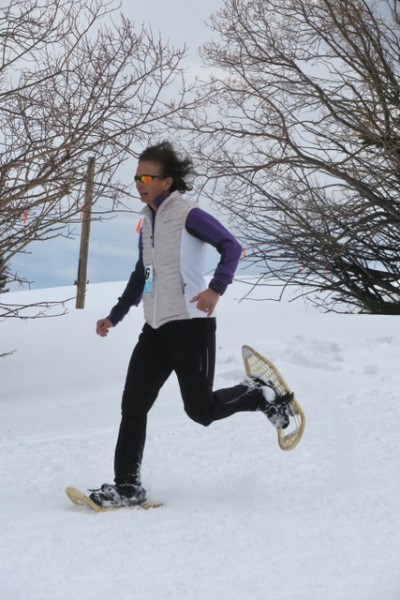
Judy using her Maine Guide Snowshoes while racing a 10k at Beaver Creek, part of the Beaver Creek Running Series. Photo courtesy of Judy Holmes.
Judy Holmes, age 65, currently lives in Montana. She started snowshoeing in 1976 while working at L. L. Bean in Freeport, Maine. Judy and co-workers would go out snowshoeing at night with headlamps on at local state parks. Growing up in nearby Portland, she loved all snow sports, from telemark skiing, snowboarding, and alpine and Nordic skiing. Having lived in ski areas the past 35 years, Judy said, “Snowshoeing was something I could do after the lifts closed.”
Her first competition was in Colorado, the 1990 Mountain Man Winter Triathlon. “I think it was 15 miles of cross-country skiing, both uphill and down Beaver Creek mountain, then 10 miles of snowshoeing up and down the mountain, followed by 20 miles of speed skating on Nottingham Pond in nearby Avon.”
Judy was racing on metal snowshoes with running shoes bolted to them. That is until about five years ago when a Maine Guide in the Moosehead Lake region told her about the Maine Guide Snowshoes. After visiting Bob and Andrea Howe, she never looked back. They built her several pairs of wooden snowshoes that are shorter and narrower than standard models. Her custom-designed ‘shoes also have grips on the bottom for uphill runs. They have worked great! For the next several years, Judy never came in lower than 3rd in a race in her age group. “In most of my races, I was the only one on wooden shoes.” And you can bet hundreds of participants noticed the snowshoes, especially with the red and purple lacing!
Maine Guide: The Real Deal
This small, family-owned business in northern Maine embodies what snowshoeing is all about: a love for snowshoes, the community, and the great outdoors.
Read More: Snowshoeing Destinations In Maine
Have you heard of or used Maine Guide Snowshoes? Let us know in the comments below!

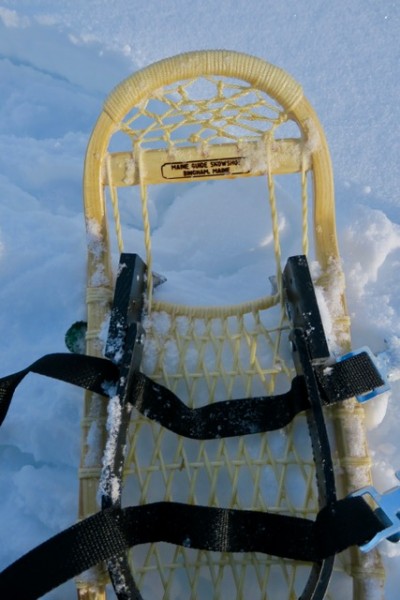
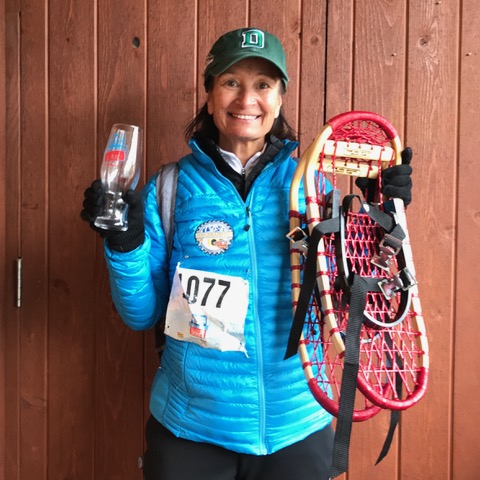
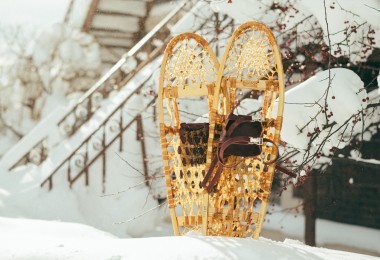
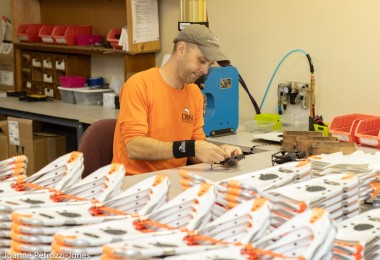
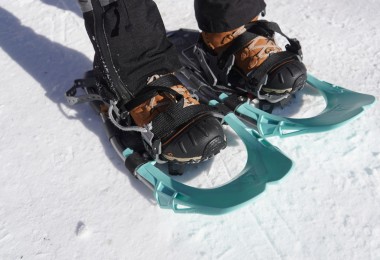
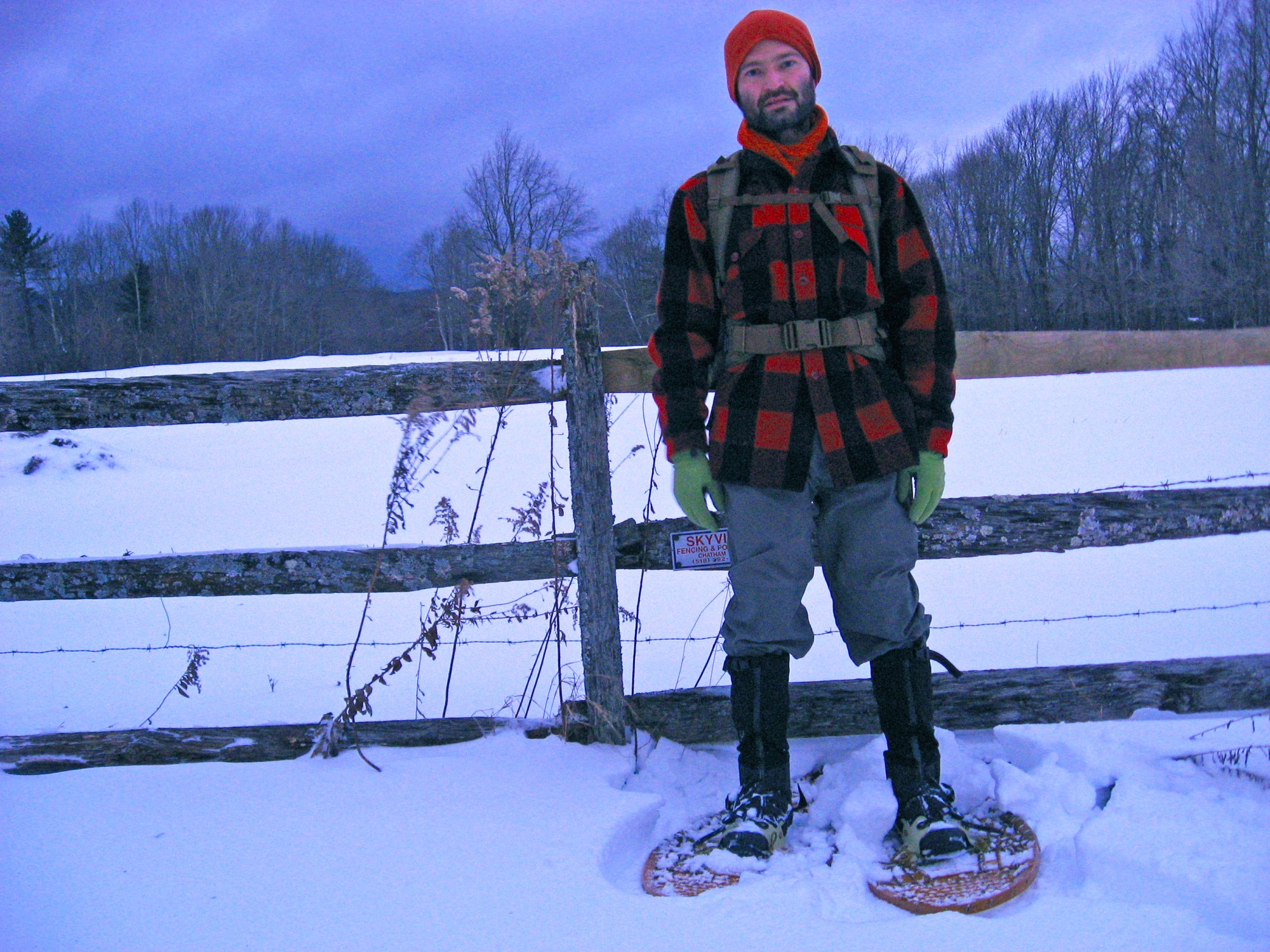

I bought a pair for me and my husband. We own a camp in Maine that has lots of land and trails. We have been out in VERY DEEP snow and these are amazing. We have used them for the last 3 years several times a week and they are still like new. Can’t say enough good things about them. They were/are well worth the investment.
I have handled the Rabbit Hunter model while visiting the Sportsmans Show in Springfield in the past. There is another thing about modern aluminum vs traditional wooden snowshoes; NOISE. He told me a story of how he noticed that when he guided hunters wearing modern metal shoes they did not see game. It appears that they can hear the tinny aluminum sounds over snow more so than the traditional silent wooden frames. That is why I do not like modern shoes.
Yes! Wooden snowshoe models are definitely quieter than modern models, especially aluminum models. The quiet the wood frame provides is definitely helpful when hunting and listening to the sounds of the forest. Thanks for sharing your thoughts, John! – Susan, SSM Editor